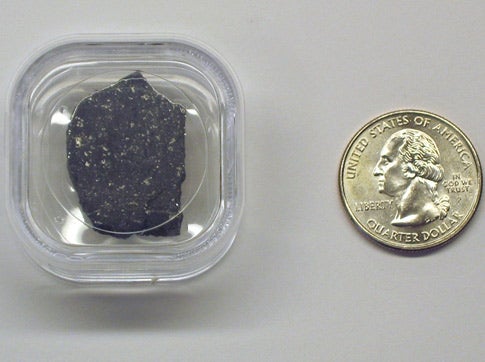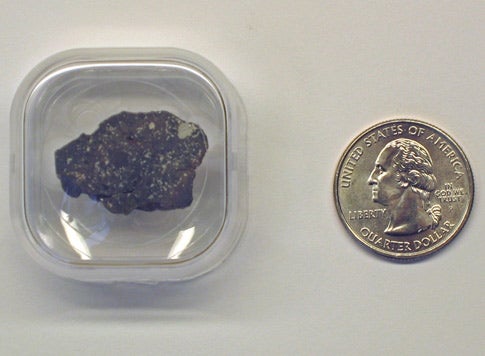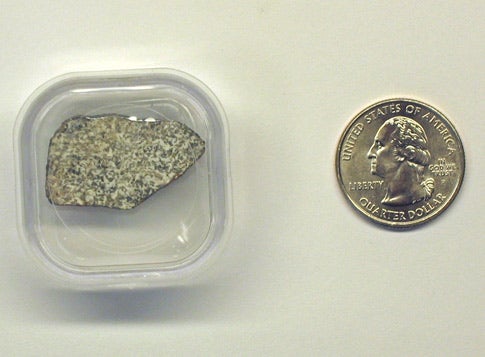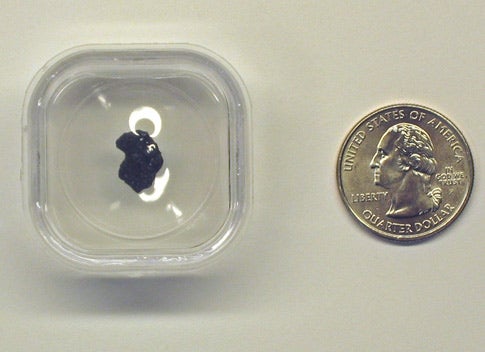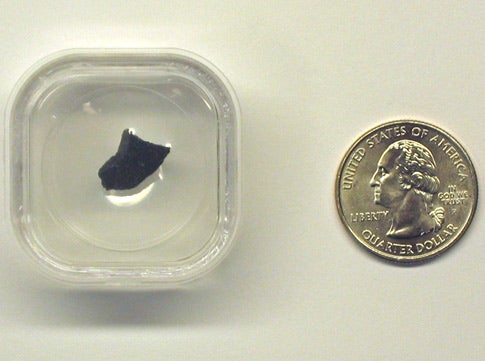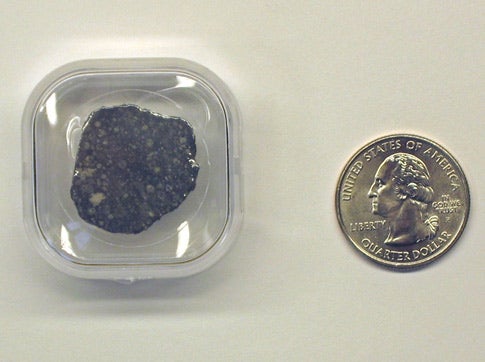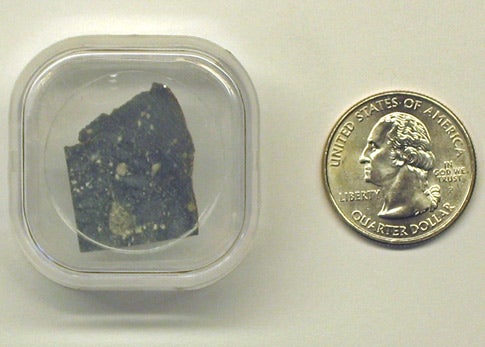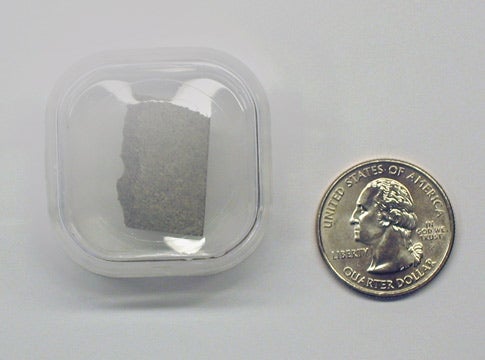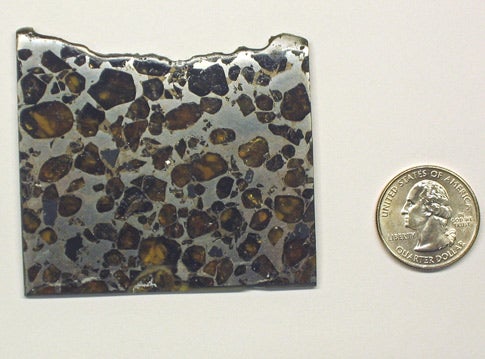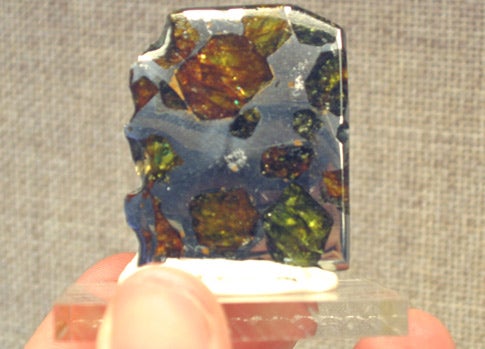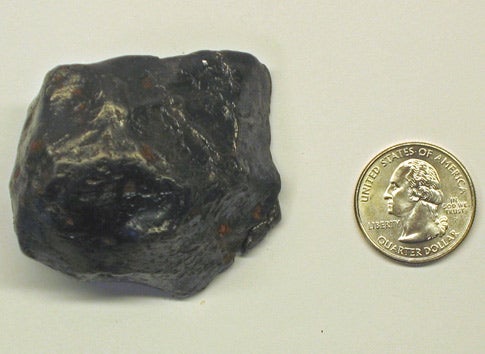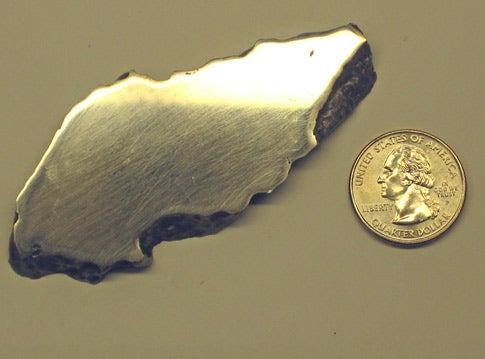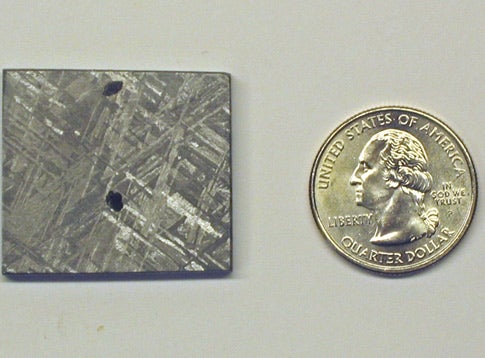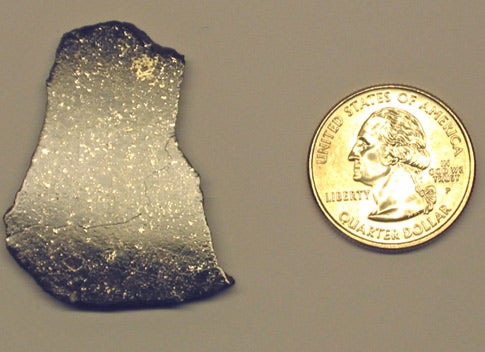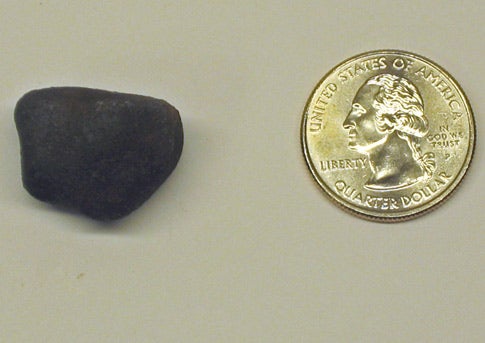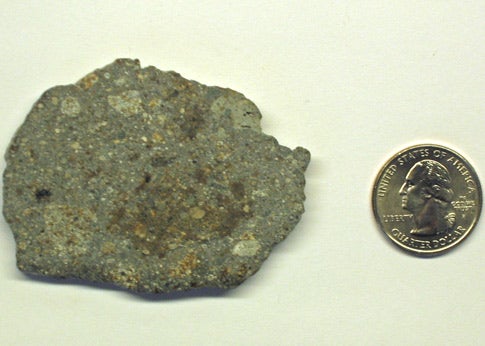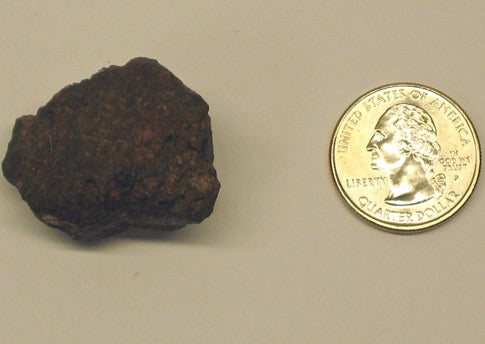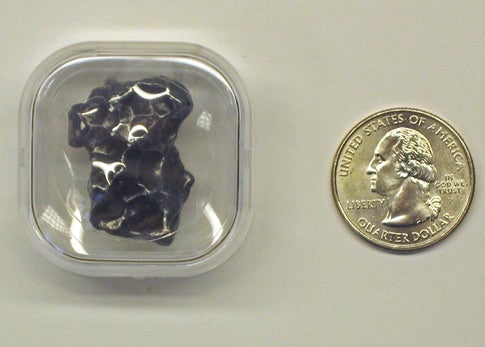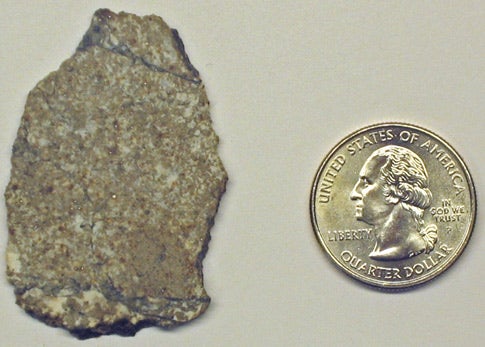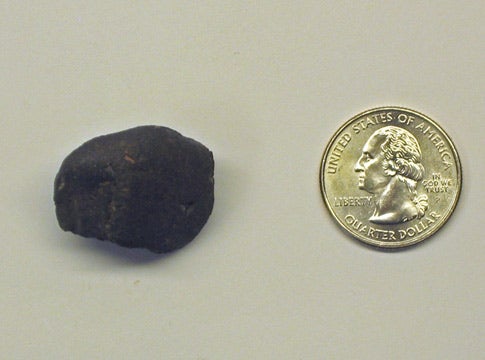All meteorites are from the David J. Eicher collection; photos courtesy Astronomy: David J. Eicher
Park Forest, Cook County, Illinois
This 4.0-gram slice is part of the meteorite that fell over the Chicago suburbs on March 26, 2003. It’s a stone meteorite, L5 chondrite, and about 18 kg total have been recovered.
This 4.0-gram slice is part of the meteorite that fell over the Chicago suburbs on March 26, 2003. It’s a stone meteorite, L5 chondrite, and about 18 kg total have been recovered.
Vaca Muerta, Taltal, Atacama, Chile
Spanish for “dead cow,” Vaca Muerta got its name lying in proximity to dead cattle in the barren Atacama Desert. It was found in 1861 and is a rare stony-iron mesosiderite; this 8.7-gram slice is a mixture of iron and achondrite that may have been “soil” on an asteroid.
Spanish for “dead cow,” Vaca Muerta got its name lying in proximity to dead cattle in the barren Atacama Desert. It was found in 1861 and is a rare stony-iron mesosiderite; this 8.7-gram slice is a mixture of iron and achondrite that may have been “soil” on an asteroid.
Millbillillie, Wiluna District, Western Australia
The meteorite called Millbillillie is extraordinary in that few stones from space have been tied to a specific parent body. Millbillillie, however, is a stone achondrite of a rare type called a euchrite, which is tied to the asteroid 4 Vesta. The rock fell in October 1960; this is a 3.03-gram slice.
The meteorite called Millbillillie is extraordinary in that few stones from space have been tied to a specific parent body. Millbillillie, however, is a stone achondrite of a rare type called a euchrite, which is tied to the asteroid 4 Vesta. The rock fell in October 1960; this is a 3.03-gram slice.
Tagish Lake, British Columbia, Canada
On January 18, 2000, a meteorite fell on Tagish Lake that proved to be exceedingly rare. A stone, Tagish Lake is a unique carbonaceous chondrite (C2, ungrouped). It represents matter relatively far out in the solar system, and the 10 kg that were recovered represent some of the oldest, most primitive matter known in the solar system. This is a 0.223-gram fragment.
On January 18, 2000, a meteorite fell on Tagish Lake that proved to be exceedingly rare. A stone, Tagish Lake is a unique carbonaceous chondrite (C2, ungrouped). It represents matter relatively far out in the solar system, and the 10 kg that were recovered represent some of the oldest, most primitive matter known in the solar system. This is a 0.223-gram fragment.
Murchison, Victoria, Australia
When it fell September 28, 1969, the Murchison meteorite immediately attracted attention, and the spotlight grew after it was taken to the laboratory. This type II (CM2) caarbonaceous chondrite, also primitive like Tagish Lake, became the first known meteorite in which amino acids, the building blocks of proteins, were found. This is a 0.41-gram chip.
When it fell September 28, 1969, the Murchison meteorite immediately attracted attention, and the spotlight grew after it was taken to the laboratory. This type II (CM2) caarbonaceous chondrite, also primitive like Tagish Lake, became the first known meteorite in which amino acids, the building blocks of proteins, were found. This is a 0.41-gram chip.
Allende, Chihuahua, Mexico
The Allende meteorite fell February 8, 1969, and immediately became a darling of collectors due to the spectacular inclusions it contains. This stone, type III (CV3) carbonaceous chondrite, contains well-formed chondrites and white spots called calcium-aluminum inclusions that formed as droplets of molten minerals in the early solar system solidified. This 6.7-gram fragment of rock from space predates Earth.
The Allende meteorite fell February 8, 1969, and immediately became a darling of collectors due to the spectacular inclusions it contains. This stone, type III (CV3) carbonaceous chondrite, contains well-formed chondrites and white spots called calcium-aluminum inclusions that formed as droplets of molten minerals in the early solar system solidified. This 6.7-gram fragment of rock from space predates Earth.
Dar al Gani 400, Hammadah al Hamra, Libya
Of the 24,000 or so meteorites known to date, 42 came from the Moon. The largest lunar meteorite, Dar al Gani 400, was recovered in the Libyan desert on March 10, 1998. Altogether, about 1.425 kg were recovered; this is a 0.5-gram slice of the rock, which is a stone achondrite, lunar (ALUN-A).
Of the 24,000 or so meteorites known to date, 42 came from the Moon. The largest lunar meteorite, Dar al Gani 400, was recovered in the Libyan desert on March 10, 1998. Altogether, about 1.425 kg were recovered; this is a 0.5-gram slice of the rock, which is a stone achondrite, lunar (ALUN-A).
Zagami, Katsina Province, Nigeria
Even fewer meteorites, 34, are known to have come from Mars. This exceedingly rare class of space rocks gives scientists their only Mars rocks on Earth; isotopes of gas trapped within the rock tie them to Mars by way of the Viking lander data. The largest Mars meteorite, Zagami, fell October 3, 1962, and had a total mass of 18,100 grams. This 1.7-gram slice came from the noted meteorite dealer who bought the whole stone in Africa, Robert Haag.
Even fewer meteorites, 34, are known to have come from Mars. This exceedingly rare class of space rocks gives scientists their only Mars rocks on Earth; isotopes of gas trapped within the rock tie them to Mars by way of the Viking lander data. The largest Mars meteorite, Zagami, fell October 3, 1962, and had a total mass of 18,100 grams. This 1.7-gram slice came from the noted meteorite dealer who bought the whole stone in Africa, Robert Haag.
Brahin, Minsk, Gomel Province, Belarus
The most beautiful meteorites are those stony-irons called pallasites, a fusion of metal and mineral. While iron meteorites originated from the cores of asteroids and stones from the outer mantle, pallasites presumably form from an outer part of the core in which the iron-nickel cools quickly, leaving olivine to squirt through the cavities and crystallize. This Brahin slice weighs 41.6 grams.
The most beautiful meteorites are those stony-irons called pallasites, a fusion of metal and mineral. While iron meteorites originated from the cores of asteroids and stones from the outer mantle, pallasites presumably form from an outer part of the core in which the iron-nickel cools quickly, leaving olivine to squirt through the cavities and crystallize. This Brahin slice weighs 41.6 grams.
Esquel, Chubut, Argentina
Considered the prettiest of all meteorites, Esquel is a pallasite that was found in 1951 and contains the best, gem-quality olivine (called peridot) found in a meteorite. About 1,500 kg of this meteorite have been found; this slice weighs 25.0 grams.
Considered the prettiest of all meteorites, Esquel is a pallasite that was found in 1951 and contains the best, gem-quality olivine (called peridot) found in a meteorite. About 1,500 kg of this meteorite have been found; this slice weighs 25.0 grams.
Canyon Diablo, Coconino County, Arizona
A piece of the rock that struck Earth 50,000 years ago, creating the Barringer Meteor Crater, this 235.4-gram iron is a classic for all meteorite collections. The meteorite was recognized in 1891; it is an iron octahedrite, coarse (IA). The main mass was vaporized, and about 30 tons have been found.
A piece of the rock that struck Earth 50,000 years ago, creating the Barringer Meteor Crater, this 235.4-gram iron is a classic for all meteorite collections. The meteorite was recognized in 1891; it is an iron octahedrite, coarse (IA). The main mass was vaporized, and about 30 tons have been found.
Chinga, Tanna Tuva, Tanna Republic, Russia
A special type of iron meteorite, ataxites have an extremely fine crystalline structure that allows them to be sliced and polished like mirrors. This meteorite was found in 1913 and about 250 kg have been recovered; this is an 82.8-gram slice.
A special type of iron meteorite, ataxites have an extremely fine crystalline structure that allows them to be sliced and polished like mirrors. This meteorite was found in 1913 and about 250 kg have been recovered; this is an 82.8-gram slice.
Gibeon, Great Nama Land, Namibia
One of the classic irons, Gibeon is so stable it is often cut and fashioned into jewelry. This fine octahedrite (IVA) shows the classic Widmanstatten pattern of crystallization that is unique to meteorites, after being etched with a weak acidic solution. This is a 25.4-gram specimen.
One of the classic irons, Gibeon is so stable it is often cut and fashioned into jewelry. This fine octahedrite (IVA) shows the classic Widmanstatten pattern of crystallization that is unique to meteorites, after being etched with a weak acidic solution. This is a 25.4-gram specimen.
Ghubara, Jidat al Harasis, Oman
A strange type of stone, Ghubara is a so-called black xenolithic (L5) chondrite, an object that underwent melting and recrystallization at very high temperatures. Found in 1954, the stone weighed about 226 kg; this is an 8.9-gram slice.
A strange type of stone, Ghubara is a so-called black xenolithic (L5) chondrite, an object that underwent melting and recrystallization at very high temperatures. Found in 1954, the stone weighed about 226 kg; this is an 8.9-gram slice.
Gao-Guenie, Gao, Burkina-Faso, Western Africa
This whole stone weighing 12.6 grams originated from the fall of March 5, 1960, in Western Africa, that turned out to be a stone, olivine-bronzite chondrite, type H5. Altogether, about 100 kg have been recovered.
This whole stone weighing 12.6 grams originated from the fall of March 5, 1960, in Western Africa, that turned out to be a stone, olivine-bronzite chondrite, type H5. Altogether, about 100 kg have been recovered.
NWA 869, Tindorf, Algeria
Showing extraordinary chondrules and a brecciated (mixed and remelted) texture, NWA 869 was found in 1999 and is classed as an L3.5 to L6 chondrite. This remarkable slice weighs 42.2 grams.
Showing extraordinary chondrules and a brecciated (mixed and remelted) texture, NWA 869 was found in 1999 and is classed as an L3.5 to L6 chondrite. This remarkable slice weighs 42.2 grams.
Gold Basin, Mohave County, Arizona
Found November 24, 1995, when a geologist was prospecting for gold ore, Gold Basin is an ordinary chondrite of type L4. About 169 kg have been recovered; this whole stone weighs 28.0 grams.
Found November 24, 1995, when a geologist was prospecting for gold ore, Gold Basin is an ordinary chondrite of type L4. About 169 kg have been recovered; this whole stone weighs 28.0 grams.
Sikhote-Alin, Maritime Province, Russia
One of the best known and most plentiful irons, Sikhote-Alin is famous for its beautiful, sculpted shapes. An iron octahedrite, coarsest (IIB), Sikhote-Alin has given up about 23 tons to collectors after falling on February 12, 1947. This is a 16.7-gram individual.
One of the best known and most plentiful irons, Sikhote-Alin is famous for its beautiful, sculpted shapes. An iron octahedrite, coarsest (IIB), Sikhote-Alin has given up about 23 tons to collectors after falling on February 12, 1947. This is a 16.7-gram individual.
Dhofar 007, Oman
A cousin of Millbillillie, Dhofar 007 is also a euchrite (achondrite, cumulate), and very well may also be solidified lava from the asteroid 4 Vesta. Found in 1999, the meteorite consists of 21 kg; this is a 6.4-gram slice.
A cousin of Millbillillie, Dhofar 007 is also a euchrite (achondrite, cumulate), and very well may also be solidified lava from the asteroid 4 Vesta. Found in 1999, the meteorite consists of 21 kg; this is a 6.4-gram slice.

